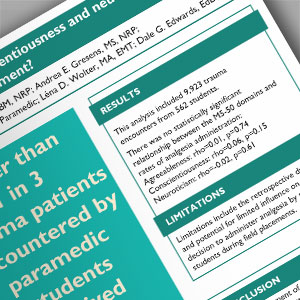ABSTRACTS
How Do the M5-50 Domains of Agreeableness, Conscientiousness and Neuroticism Impact Oligoanalgesia in Paramedic Students on Field Placement?Author: Scott Lancaster PhD, MHA, NRP | Assistant Dean of Health Professions | Northern Essex Community College Associate Authors: Crowe, Remle PhD, NREMT Fuge, Sam., BM, NRP O’Leary, Megan BA | Keating, Glenn. BS. NRP | Steeby, M. Andrew MA, Paramedic | Wolter, Lena BS, EMT | Edwards, Dale EdD, FPA
Introduction Out-of-hospital analgesia administration for patients with pain from traumatic injuries is low and differs by variables such as patient age, gender, ethnicity. The relationship between affective characteristics of the provider and the rate of out-of-hospital analgesia administration has not been thoroughly explored. The aim of this study was to assess the association between the M5-50 domains of agreeableness, conscientiousness and neuroticism, as utilized by Fisdap (an online EMS database) and the administration of analgesic medications to trauma patients by paramedic students during field placements. Hypothesis Students who score high in the domains of agreeableness and conscientiousness on the Paramedic Entrance Exam administer analgesia more often than those with lower scores, while those with high scores in neuroticism administer analgesia less often than those with low scores. Methods A retrospective review of Fisdap paramedic student records from 2017 to 2019 was conducted. Records with complete entrance exam data and at least one field contact with a trauma impression were included. Records with airway interventions were excluded as these procedures are more likely in patients who are not alert. Independent variables included scores for agreeableness, conscientiousness and neuroticism. The outcome variable was the analgesia administration rate by paramedic students. Spearman’s correlation coefficients were used to assess the relationship between each affective characteristic and analgesic administration rate. Results Records for 9,923 trauma encounters documented by 562 students representing 66 paramedic education programs were included. Encounters per student ranged from 1 to 66 with a median of 16 encounters (IQR: 11-23). Overall, 32% (n=3,209) of patients were administered one or more analgesic agents. The median rate of analgesic administration per student was 29% (IQR: 14%-46%). No statistically significant relationship between agreeableness (rho=0.014, p=0.740), conscientiousness (rho=0.0602, p=0.154), or neuroticism (rho=-0.0215, p=0.611) and the rate of analgesia administration was observed. Conclusion While oligoanalgesia represents an area of concern in out-of-hospital care, no statistically significant relationship between agreeableness, conscientiousness or neuroticism and analgesia administration rate was observed. Limitations include the retrospective data and potential for limited influence on decision to administer analgesia by paramedic students during field placements.
|

